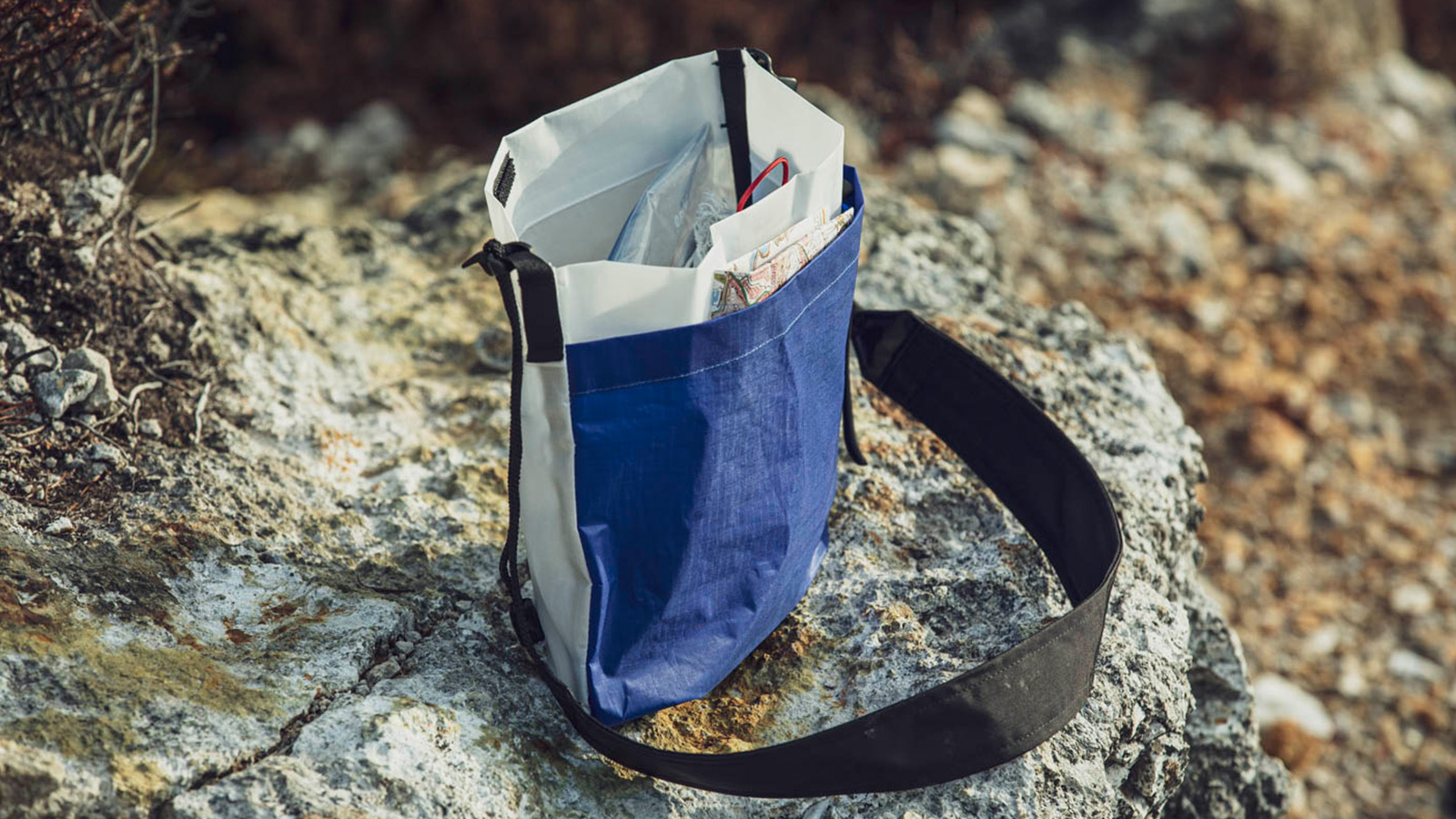40g (Size M)
43g (Size L)
*Minor variations may exist due to product individuality.
Introduction
Soft merino wrap
Our 100% merino wool cap fits snugly on your head.
The brim is short enough to keep the cap secure even in high winds and with its relatively deep crown, simple size-adjusted, and timeless design, this is a cap designed with the utmost in comfort and ease of use in mind. Neither too thick nor too thin, and with a premium feel, this cap can be worn throughout the year for hiking in all seasons.
Please note: the brim is not memory-shape fabric like our other hats.
Product story
Warm and comfy
Our Merino Cap is comfortable even during Japan’s sweltering summer months and both when walking or sleeping. It keeps you shielded from the sun’s harsh rays and stays put even in strong winds up high on the ridge.

The idea for creating this cap came from the fact that our Yamatomichi Stretch Mesh Cap was a bit cold during the winter months. We wanted a cap that could perform equally well during both fall and winter. We thought about making a cap using merino wool similar to our Merino Henley T-shirt. Other brands were producing their own merino caps, but we personally felt that the material they were using was simply too thick.
I started testing different fabrics in the spring of 2016. As expected, thick merino wool was too warm during the summer, but there was something about the soft, gentle fabric that was worth exploring. I think we have now found the perfect thickness that works well throughout most of the year.
Form and function
Single-hand adjuster
The low-profile adjuster offers quick single-hand fitting. When you sleep with the cap on, the adjuster does not cause any discomfort.
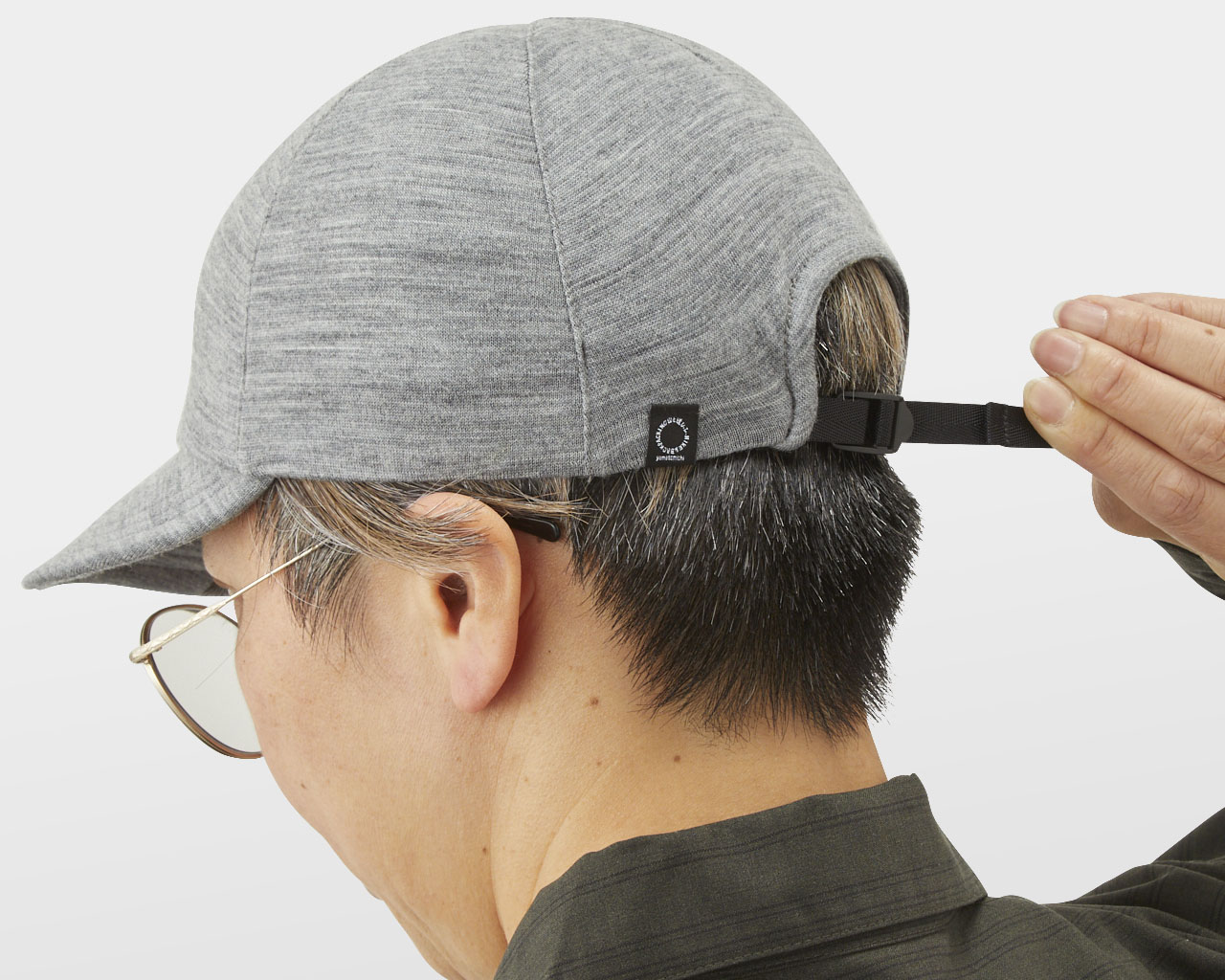
Details
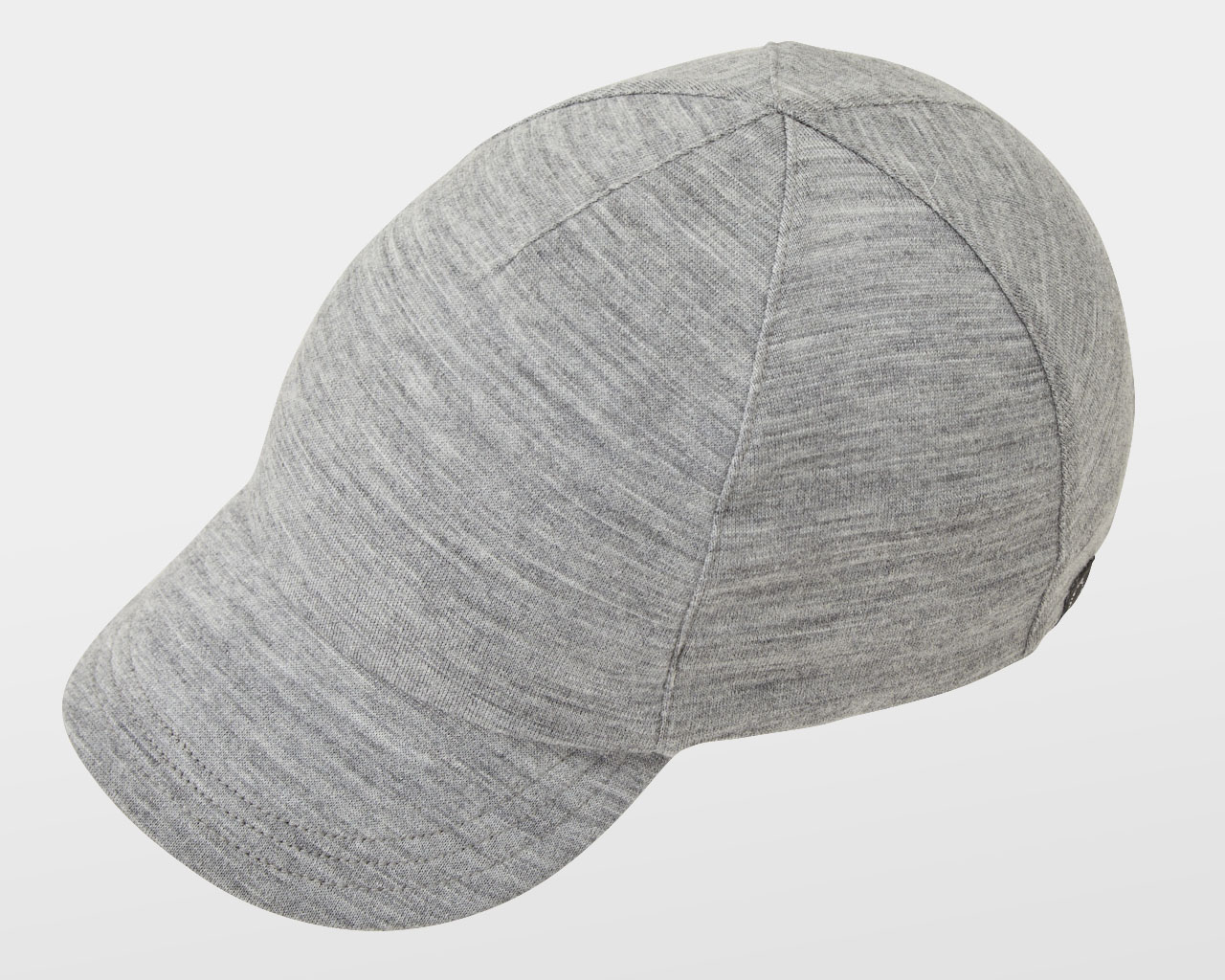
The crown has an overall rounded shape with a deep fit.

For maximum comfort remove the rebel by carefully cutting the thread.
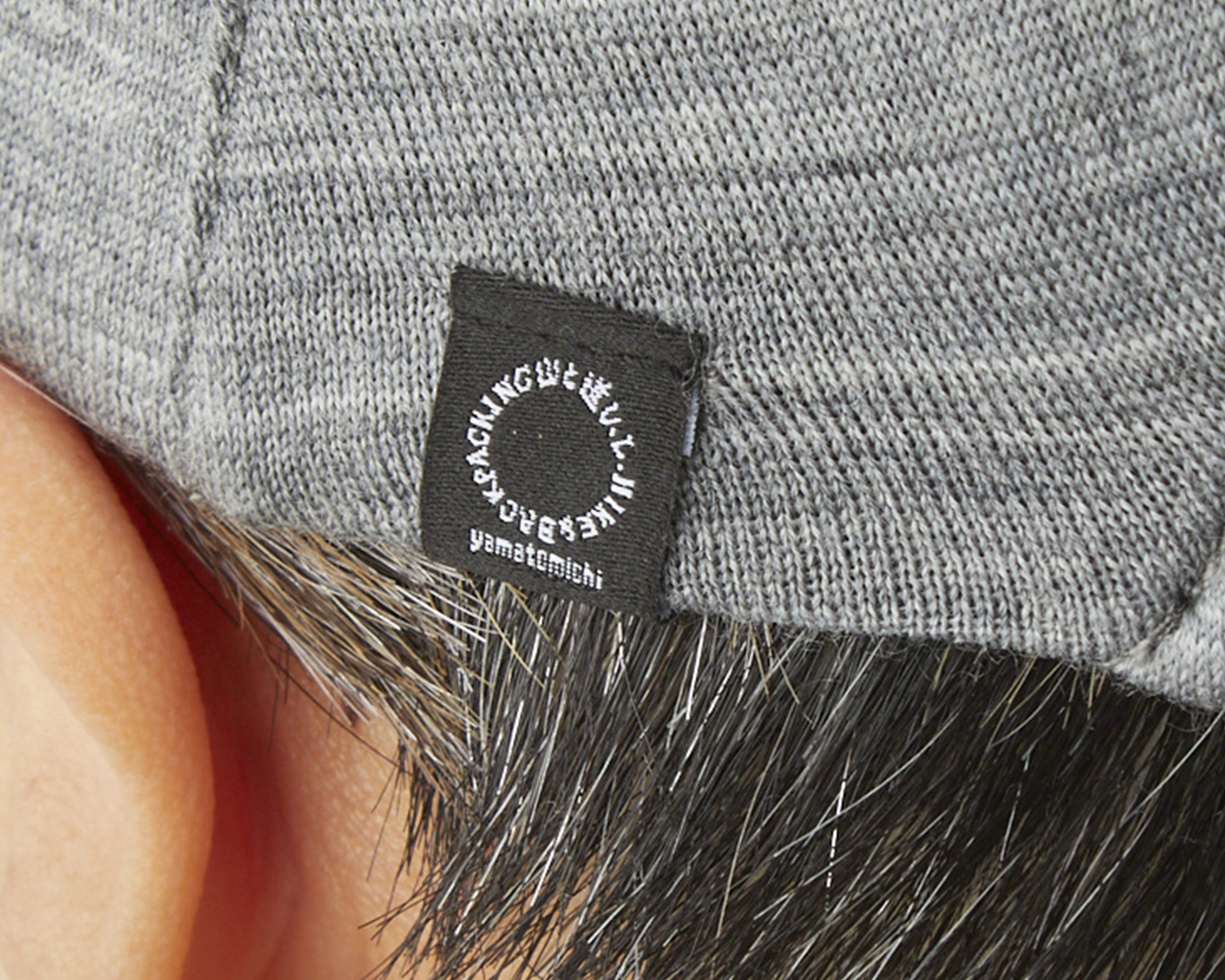
Wool’s deodorant mechanism is still a mystery. One theory has it that wool absorbs a large amount of odor-causing elements, and consequently, the odor is minimized to the level that cannot be detected by the sense of smell. We will conduct our own experiments and tests in the future.
Naturally odor resistant
Wool clothes are chosen by many hikers for the material’s excellent odor neutralizing performance. Some say it’s almost odor-free even after a week of heavy hiking, but we’ll let you (and your friends) be the judge of that…
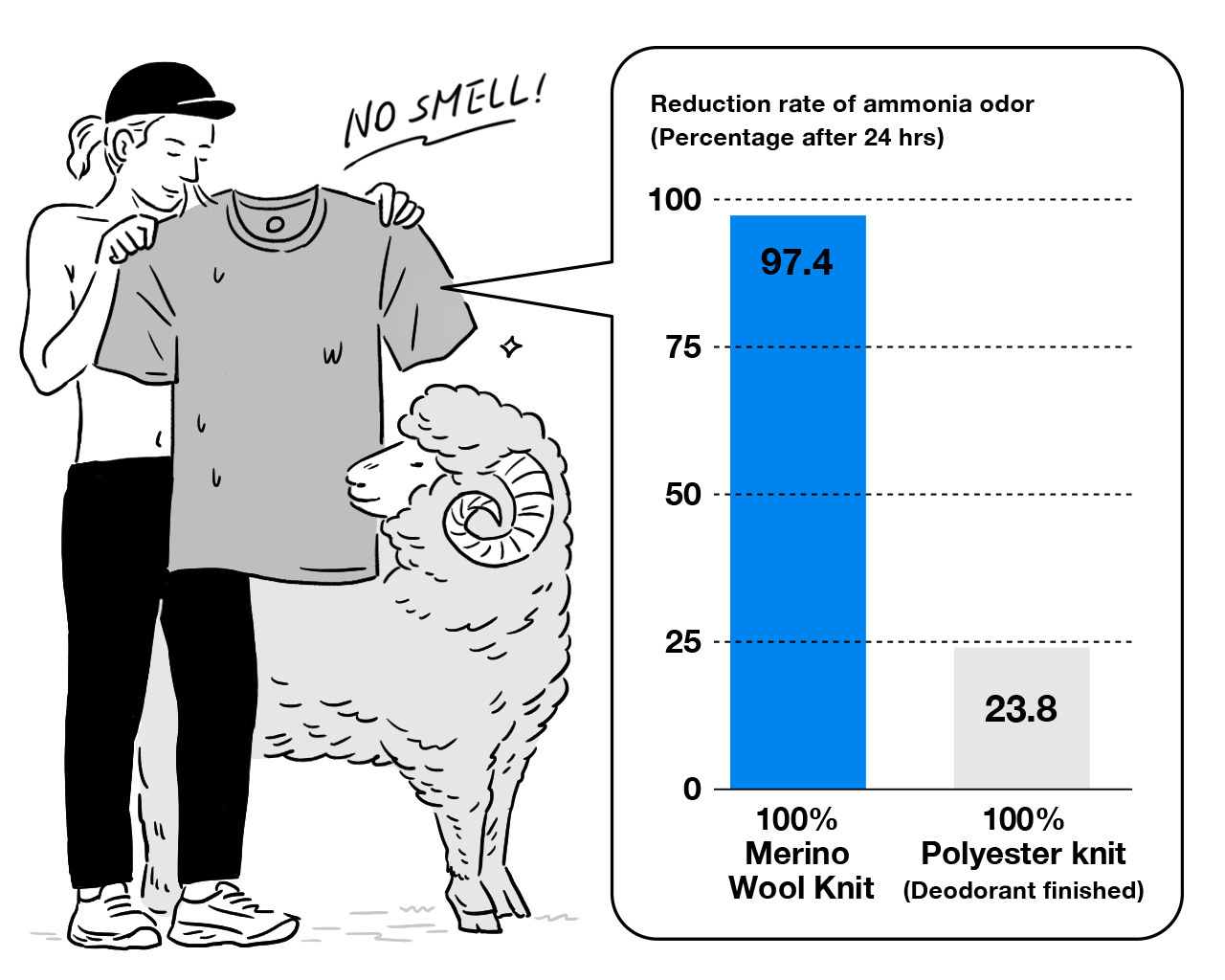
Wool’s deodorant mechanism is still a mystery. One theory has it that wool absorbs a large amount of odor-causing elements, and consequently, the odor is minimized to the level that cannot be detected by the sense of smell. We will conduct our own experiments and tests in the future.
Great moisture control
Merino wool, often called “nature’s air conditioner,” regulates temperature and humidity inside your clothing to keep you comfortable.
Its unique ability to stay cool in the heat yet warm in the cold comes from two key properties: the natural crimp of the fibers, which creates air pockets for breathability and moisture transfer, and the cortex, which adapts its moisture absorption to the surrounding humidity—taking in more as the air gets damp.
The insulating air layer formed by the crimp functions like down or synthetic fill, trapping warmth. As a result, Merino offers superior insulation compared to cotton or standard synthetic fibers of the same weight.

Warm when wet
First, when wool absorbs moisture, the thermal phenomenon called “absorption heat” is generated. Secondly, its excellent insulation properties (low thermal conductivity) prevents the body heat from being lowered by evaporation. Also, the crimped fibers are bouncy and retain loft without crushing even when wet.
In addition, wool can absorb more moisture in between the fibers, always keeping the skin dry and comfortable.
Consequently, 100% Merino wool keeps you warm during the action, even in severe weather that makes you wet to the skin.

Material
Why 100% merino?
Wool is a natural material with various unique features such as temperature/moisture control, thermal insulation, and is naturally odor-resistant. All developed by sheep to survive the harsh environment over time.
While many other manufacturers add synthetic fibers to strengthen their Merino fabrics, we wanted to stick with 100% Merino to maximize the natural benefits of pure merino wool. Our merino will keep you dry even when it’s hot and humid and comfortable no matter the climate.
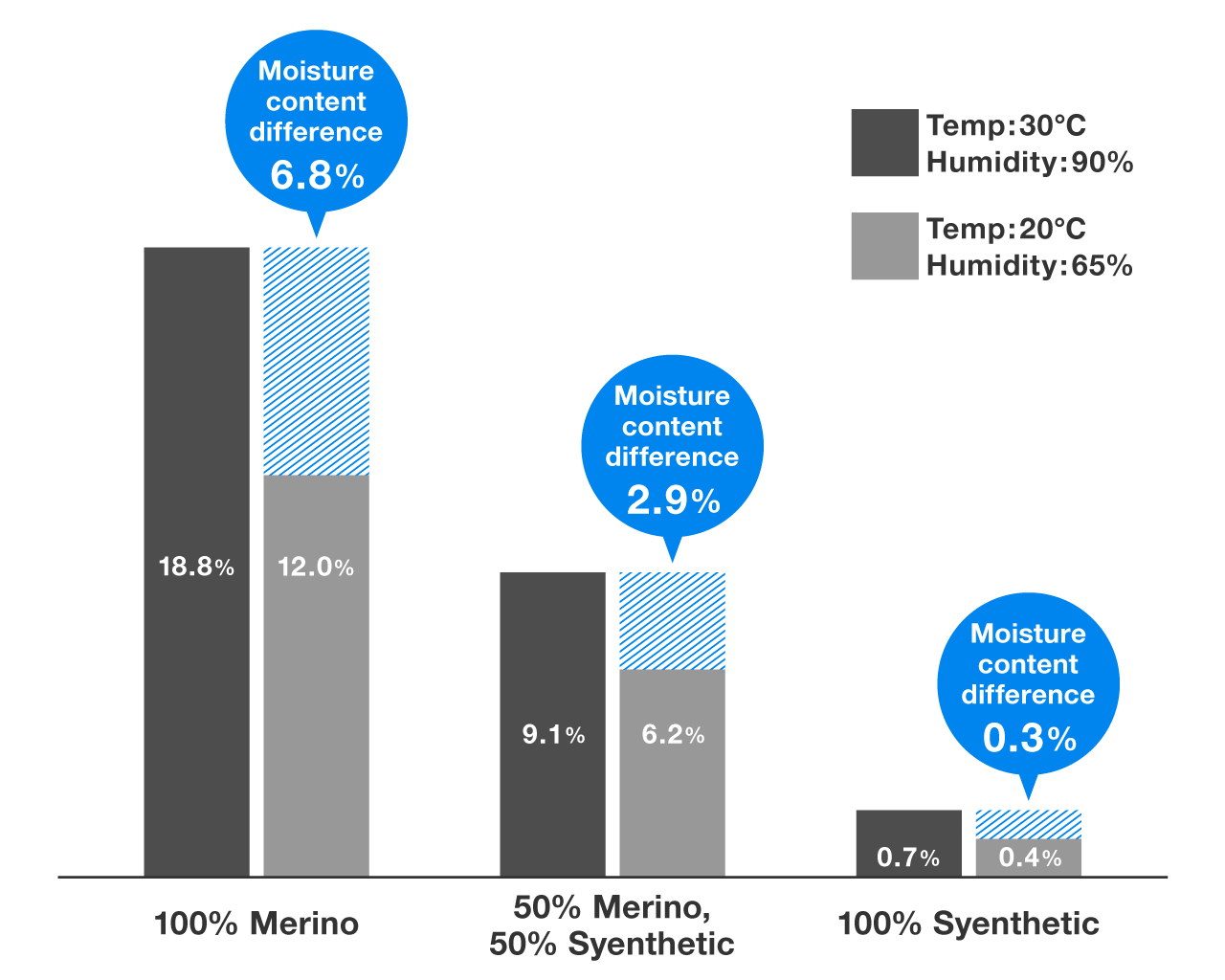
The above chart shows the comparison of moisture content ratio of three types of fabrics in a humid and hot environment (up, 30˚C with 90% humidity) and a more comfortable environment (down, 20˚C with 65% humidity).
In a humid and hot environment, the fiber with superior moisture absorption keeps you dry and comfortable. On the other hand, in dry conditions, it is more comfortable when the fiber provides a certain level of moisture without excessively absorbing available humidity. The difference of the moisture content ratio in the above chart indicates the moisture control performance: the greater the value is, the better the fabric’s moisture control performance is, therefore the larger percentage means better comfort.
The 100% merino fabric, as shown above, has a 6.8% moisture ratio difference. This means that our merino material can effectively control the moisture compared to the other fabrics, keeping you dry when it’s hot and humid while supplying a moderate amount of moisture when the humidity is low.
This is the reason why the merino wool is known as “a natural air conditioner”.
Merino wool
Wool is a natural material with various unique features such as temperature/moisture control, thermal insulation, and anti-odor performance; all of them developed by sheep to survive the harsh environment over time.
Merino wool comes from merino sheep and compared to other kinds of wool, merino’s fiber is finer, softer, and less scratchy, and hence even suitable for making underwear.
All wools, including merino wool, are cool in summer and warm in winter. It is warm even when it’s wet, and practically odor-free even after many hours of wear.
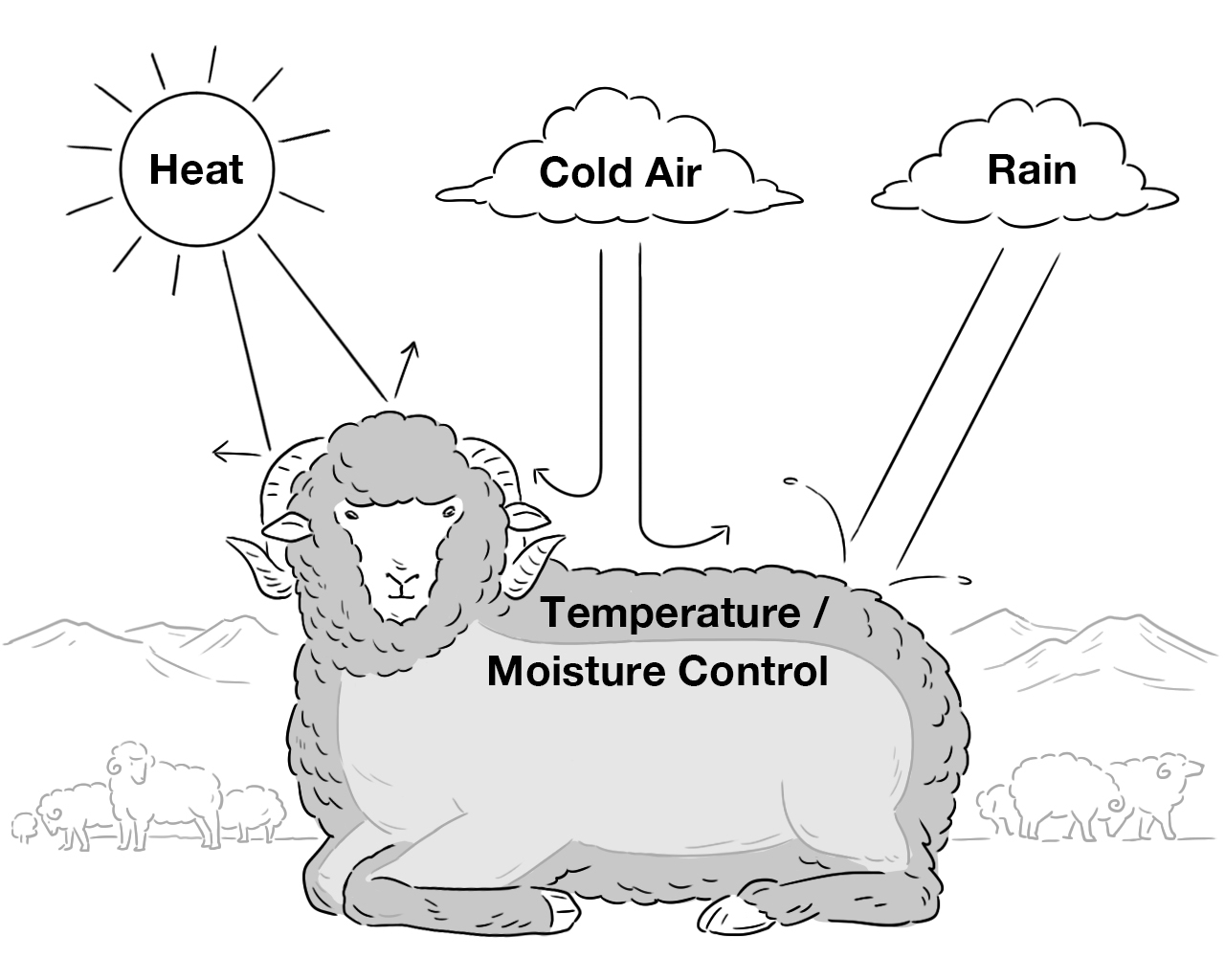
Wool’s structure
The wool’s fiber is composed of the amino acid-based protein, just like human hair and skin. The surface is called the “scale”, which is similar to a fish scale, and the inner part is the “cortex”.
The cortex is composed of ortho-cortex and para-cortex, each with different moisture absorption performance. Because each of them differs in property, the combination of ortho and para cortexes makes the fiber “crimped”.
This crimped structure produces the wool’s unique features such as moisture/temperature control property and thermal insulation performance, avoiding the coldness caused by the sweat.
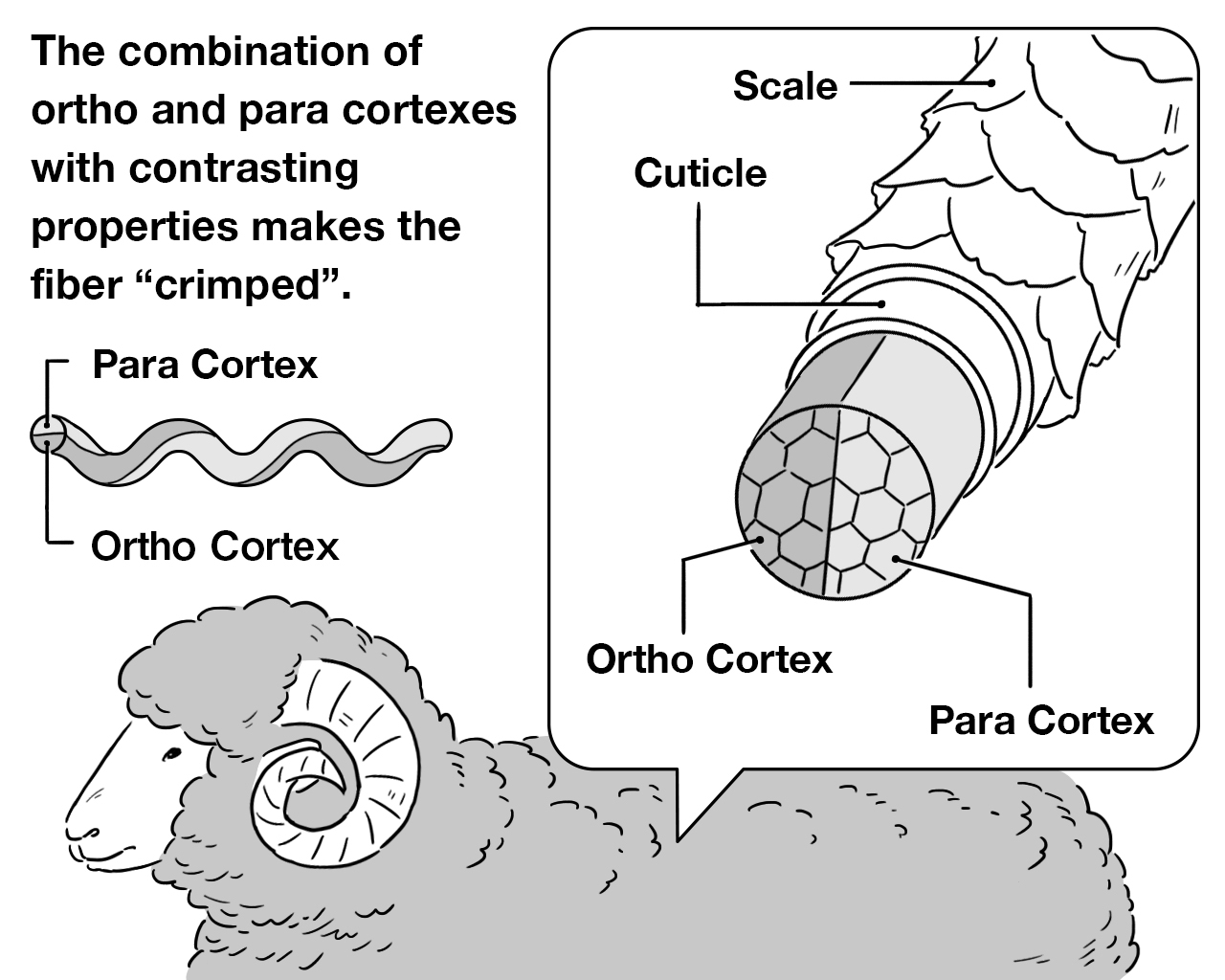
Disadvantages of wool
As explained above, wool or merino wool has various features and functions, but it is not flawless.
Heavy when wet
Since the wool is capable of containing a significant amount of water in its fiber, it can be heavy when it’s wet and takes longer to dry compared with most synthetic materials.
Fast-drying synthetic materials, however, can be cold when wet because it deprives body heat excessively quickly as it dries due to evaporation. Wool dries slower than synthetic materials but quicker than cotton with a similar thickness.
Attracts moth
Any soft fiber derived from animals, such as general wools, cashmere, and silk particularly attracts moths.
Tears easily
Wools have short fibers, which can fall out due to friction, possibly causing small holes in the fabric. Compared with synthetic materials or cotton, wool tear more easily.
Distortion
When the knitted wool garments are washed, the material is likely to distort diagonally because the yarned fibers absorb water, swell, and tend to untwist. Consequently, the shape of the shirt may distort slightly with washing.
Wool’s scent
Due to the nature of animal fibers, you may smell a distinctive scent or odor when the fabric is wet, especially after dewatered, but the scent disappears after drying.
The above information was compiled and edited based on the interview with the textile company and the research institute, and the reference book below:
Bibliography:
Structure and Physical Properties of Wool, Japan Wool Industry Association, Seni Co., Ltd.
Size guide
Product size

Unit:cm
| Size | S | M | L |
|---|---|---|---|
| Circumference | 48.5 − 54 | 52.5 − 58 | 56.5 − 62 |
Place the measuring tape just above your ears and measure around your head.
Fittting
Misako – Circumference 54cm
Size S (Gray Marl)
Oji – Circumference 56cm
Size M (Black)
Maho – Circumference 56cm
Size M (Gray Marl)
Yuko – Circumference 57cm
Size L (Black)
Pony – Circumference 57cm
Size L (Gray Marl)
Kenken – Circumference 58cm
Size L (Black)
Instructions
Care instruction
- Hand wash with a mild detergent in water around 30°C.
- Gently squeeze out excess water and lay flat to dry in the shade.
- Do not use fabric softener or bleach.
- Due to the nature of the fabric, slight shrinkage or twisting may occur after washing.
Because Merino wool has excellent odor-resistant properties, it does not need to be washed frequently. However, it is also prone to moth damage and shrinkage, so proper washing and storage are essential. Please read the care instructions carefully and use them to help maintain your garment at home.
Care instruction page
For more detailed washing, drying and water repellent care instructions, visit our SUPPORT Page. With proper care you can prolong the funtionality of the product.
Payment
- We only accept payment by credit card. We currently do not accept payment via bank transfer from overseas accounts.
- We accept the following Credit Cards: Visa, Master, American Express, and JCB.
- To download your receipt, please click the link included in the Dispatch Notice, which we will send by email as soon as the items are dispatched.
- Bank transfer is only availble for those that own a Japanese bank account.
Delivery
- Order Confirmation will be sent after the order.
- The items will be dispatched within 3 days after the payment is confirmed.
- The dispatch notice will be sent by email as soon as the items are dispatched.
- The delivery may be delayed by unforeseeable reasons such as natural disasters and other logistics issues. We appreciate your patience and understanding.
- We cannot ship multiple orders in one package due to how our delivery system is currently set up.
- We will ship to regions in North America, Oceania, and Europe (excluding Russia) via DHL. For regions in Asia, the Middle East, Central and South America, Africa, and Russia, we use EMS (International Express Mail Service) for shipping.
- Shipping fees and delivery times vary depending on the shipping destination as well as the size and weight of the items.
Size exchange
- Overseas customers who need to change the size of their order, should note that the time needed for shipping will vary greatly depending on your country of residence.
- We only accept exchanges when the item is unused (except for fitting).
- If you wish to exchange the size of the item, please contact us within seven days of receiving your order.
- Exchanges can only be made for the same color in a different size.
- If the size you wish is out of stock, we will suggest a different color.
- If the product is out of stock, we may simply have to ship the item back to you.
- All shipping costs to be carried by the customer.
- We will only send the exchanged item to you, upon receipt of return shipping cost via PayPal.
- Please be aware that some countries charge customs duties depending on the price of the item.
- We are unable to answer any questions on local customs. Please contact your local customs bureau.
Repair
A natural fiber, merino wool has wonderful properties such as excellent temperature and humidity control and deodorant performances, but it also has a weakness; yarns are likely to break and develop holes due to abusive use and moth eating.
For inquiries on repairing holes or products damaged over time, please feel free to contact us from the “Repair” section of the SUPPORT page.
Needle Felting
Holes in merino wool cut-and-sewn products caused by thread breakage or moth bites can be repaired by felting, a technique to patch the hole with the raw wool using a special needle. You can repair by yourself, and Yamatomichi also offers felting repair services using raw wool of the same color as the product.
For more details of felting and how we repair the merino items, visit Yamatomichi JOURNALS “#1 Repairing Holes in Merino Wool“.















